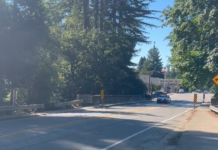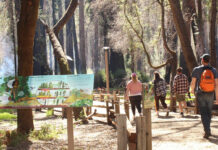Promptly at 5:00 a.m. on the rainy morning of Jan. 31, 34 teams of volunteers fanned out across the county in pre-dawn darkness to count people who do not have homes to sleep in- people sleeping on the streets, in cars and vans, or hidden away in unauthorized campsites.
The Point-in-Time Homeless Street Count is conducted every two years to document, with as much accuracy as possible, how many people across the county are actually sleeping without shelter.
The volunteer teams of “census takers” are assisted by “guides” — people who have experienced homelessness themselves and are familiar with where homeless people might be in any given neighborhood.
The Point-in-Time Homeless Street Count, led by the Watsonville-based firm Applied Survey Research, is required by the U.S. Department of Housing and Urban Development every two years to secure funding for homeless services. The data is also important in determining how current homeless programs are working, how these services may be improved, and if the numbers are growing or declining over time.
The census provides current data on the basic number, gender, approximate age (if possible), and where those without regular shelter are sleeping.
The volunteer teams are each given a map of their assigned census tract, and care is taken not to duplicate the count near the boundaries of each team’s assigned turf. In the San Lorenzo Valley, census tract boundaries are delineated by Hwy. 9, and the team assigned to the census tract on the west side of Hwy. 9 were mostly on the look-out for homeless people sleeping in vehicles parked on the street and in turn-outs along the mountain roads.
The Point-in-Time Homeless Street Count does not involve any in-depth discussion with homeless people, and is tallied by “observation only” by volunteers trying to be as unintrusive yet as accurate as possible. A dilapidated RV, with trash bags tucked underneath, condensation dripping in the windows and with movement detected inside is evidence enough for the tally of a homeless person “vehicularly housed” near Boulder Creek, without shining flashlights into the vehicle to verify.
Jane Mio, a volunteer from Santa Cruz with the team looking for homeless people on the west side of Hwy. 9, has been involved with homeless services for years.
“Personally, I think we as a society have not integrated the homeless situation as a reality into our perception,” Mio wrote to the Press Banner after the point-in-time count. “We hope some local or state agencies, or experts will eliminate that homeless reality out of our lives. Because I don’t think that will solve the situation, I have integrated the homeless reality into my life and work and volunteer for issues and programs that empower them to find their voice and place amongst us.”
“The homeless members have some very good ideas on how to address their situation and yet very little time is spent talking with them in depth,” she added in her email. “Consequently many attempted solutions do not include their ideas.”
The number of people housed in the most obvious homeless camp in Santa Cruz, the small tent-city that has sprung up on city and Caltrans-owned property behind the Gateway Plaza Shopping Center where Highway 9 meets Highway 1, were counted by a special team of health service providers who knew many of the campers, according to John Connery, senior research analyst for ASR.
Michael Sweatt, a guide for the homeless count and on and off camper at the Gateway Camp, said he does what he can to help people at the camp, tries to help resolve conflicts between the campers peaceably, and generally tries “keeping an eye on things to try to stop the stealing and tearing stuff up — so no one gets hurt, or gets too sick.”
According to Sweatt, the “Gateway Camp” was a predictable result of the closure of the city-sanctioned homeless camp on River Street at the end of November that provided space for about 50 tents. The closure of that camp, combined with about half the number of emergency shelter beds that were available in years past, made “Gateway Camp” somewhat inevitable, according to Sweatt.
“These people have to go somewhere, and behind the Gateway Center seemed to be the safest spot when it first got started,” he said.
A resident of Santa Cruz for 23 years but “on and off” homeless for the last 15 years, Sweatt explains he now has his “ducks in line” to receive SSI Disability and is planning to leave Santa Cruz for a living situation in Sacramento. Sweatt said he “wants to give something back to back to Santa Cruz” and hopes to repay the help he has received by “paying it forward” to other homeless people.
The raw data from the point-in-time homeless count is combined with data from various shelters and service providers for a comprehensive Homeless Census produced every two years by ASR. The last 2017 Homeless Census counted 2,249 homeless people in the county, 80 percent of whom were living outside of emergency or transitional shelters.
The 2017 count was up 14.5 percent from the 2015 count, but the 2017 count indicated a drop of more than one-third, by 36 percent, in the number of homeless person from the highest count on record of 3,536 in 2013. The data for 2019 is expected to be ready for release in about six months, according to ASR officials.














